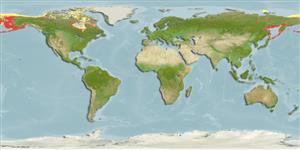Common names from other countries
Environment: milieu / climate zone / depth range / distribution range
Ecologia
marinhas demersal; intervalo de profundidade 0 - 100 m (Ref. 50550), usually 10 - 70 m (Ref. 56527). Temperate; 88°N - 40°N, 135°E - 60°W
North Pacific: Hokkaido, Japan and Sea of Okhotsk to the Bering Sea. Arctic Canada.
Tamanho / Peso / Idade
Maturity: Lm ? range ? - ? cm
Max length : 112 cm TL macho/indeterminado; (Ref. 56527)
Espinhos dorsais (total): 83 - 88; Espinhos anais 0; Raios anais moles: 53 - 54. Four pairs of strong canines on anterior parts of both jaws; molar teeth on prevomerine and palatal bones and posterior part of lower jaw. Dorsal fin without soft rays. Pelvic fins absent.
Found on rocky bottoms (Ref. 559). Benthic (Ref. 58426). Feeds on hard-shelled invertebrates (Ref. 28499).
Life cycle and mating behavior
Maturidade | Reprodução | Desova | Ovos | Fecundidade | Larvas
Eggs are very large.
Masuda, H., K. Amaoka, C. Araga, T. Uyeno and T. Yoshino, 1984. The fishes of the Japanese Archipelago. Vol. 1. Tokai University Press, Tokyo, Japan. 437 p. (text). (Ref. 559)
Categoria na Lista Vermelha da IUCN (Ref. 130435)
CITES (Ref. 128078)
Not Evaluated
Ameaça para o homem
Harmless
Utilização humana
Mais informação
ReferênciasAquaculturaPerfil para aquaculturaEstirpesGenéticaElectrophoresesHereditariedadeDoençasProcessamentoMass conversion
ColaboradoresFotografiasStamps, Coins Misc.SonsCiguateraVelocidadeTipo de nataçãoÁrea branquialOutras referênciasCérebrosVisão
Ferramentas
Relatórios especiais
Descarregue XML
Fontes da internet
Estimates based on models
Preferred temperature (Ref.
115969): -0.6 - 6.9, mean 2.3 (based on 1276 cells).
Phylogenetic diversity index (Ref.
82804): PD
50 = 0.5938 [Uniqueness, from 0.5 = low to 2.0 = high].
Bayesian length-weight: a=0.00398 (0.00174 - 0.00913), b=3.17 (2.97 - 3.37), in cm Total Length, based on LWR estimates for this (Sub)family-body shape (Ref.
93245).
Nível Trófico (Ref.
69278): 3.8 ±0.4 se; based on diet studies.
Resiliência (Ref.
120179): Baixo, tempo mínimo de duplicação da população 4,5 - 14 anos (Assuming tm>5).
Fishing Vulnerability (Ref.
59153): High to very high vulnerability (67 of 100).
